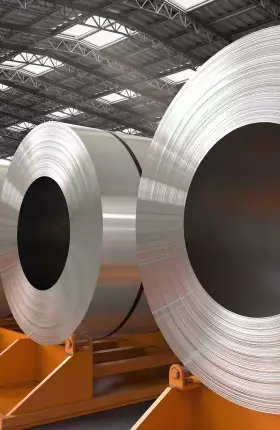The European Union’s first round of pending retaliation against sharp US tariff increases indicates the intention to take a tactical and incremental approach to the developing trade dispute with Washington. The aim: to ramp up pressure on the US to negotiate a settlement and prevent a tit-for-tat spiral into an escalating trade war.
The EU announced on April 9 that it would impose tariffs of up to 25% on a wide range of specific goods representing around €21 billion in US exports to the region in response to US tariffs on EU steel and aluminum. A wide range of sectors is impacted, with chemicals, agribusiness, and metals the hardest hit.
- The EU intends to introduce these tariffs in three phases over the course of 2025.
- The first phase—covering imports worth around €4 billion—was originally expected to come into force on April 15. This phase is expected to target products such as fruit juice, rice, textiles, and motorcycles.
- Further phases are planned to follow if there is no progress in negotiations with the US.
Shortly after the EU’s decision, the US announced it would pause applying its reciprocal tariffs for 90 days to allow space for negotiation with its trading partners. In response, the EU suspended its retaliatory tariffs for 90 days, pending the outcome of trade talks. This approach is in line with the EU’s general policy of negotiation and tactical escalation.
How the EU Is Picking Targets
Unlike China, which recently announced like-for-like tariff increases in response to US moves—which immediately triggered further escalation from the White House—the EU is taking a different approach to selecting products to target. It is considering four main factors:
- The value of imports from the US.
- The availability of alternative, non-US sources for those products, which could help businesses avoid automatically passing on the cost of tariff increases to consumers.
- The location of US production.
- The likely impact of US retaliation on EU producers.
What Comes Next
If agreement cannot be reached with the US by early July, the EU will quickly activate the first phase of tariffs, with a second phase due to kick in around a month later. According to reports, this will impact a wider range of products worth around €14 billion, including steel, white goods, trucks, glass, and ceramics. A third stage of retaliation—on products worth around €3 billion, including soybeans and almonds—would kick in around the turn of the year.
In addition to the measures agreed on April 9, further retaliation may not be far behind. For example, the EU has yet to decide on its response to the US tariffs on automotives as well as the blanket reciprocal tariffs.
It’s possible the EU could use a response tool introduced recently—the anticoercion instrument (ACI). The ACI provides the ability to retaliate against not just goods importers but also foreign services providers and investors through such measures as market access restrictions, procurement bans, and reduced enforcement of intellectual property rights. This is especially significant because the US has a services trade surplus with the EU (as opposed to a goods trade deficit).
Subscribe to receive BCG insights on the most pressing issues facing international business.
The Key Moves for EU Importers
Through each retaliatory phase, it’s expected that the EU will stick with the measured and tactical approach outlined above.
Through each retaliatory phase, it’s expected that the EU will stick with a measured and tactical approach.
We recommend the following actions for companies importing US goods into the EU:
Establish a “tariff command center” to analyze the impact of EU retaliatory tariffs. Analyze both finished goods and production inputs under different tariff escalation scenarios. This analysis should include consideration of the impact on supply chain security, procurement , pricing , taxes, and competitive position. Because the EU is taking a very targeted approach, this analysis requires a high degree of granularity to ensure impacts are properly understood.
Build “geopolitical muscle.” Businesses need to better anticipate and analyze the impact of shifts in trade policy in both the US and EU and other nations of relevance under different future scenarios. Leaders need to embed these considerations in capital allocation and strategic planning decisions. This capability is especially important now, given the volatility in trade actions and concerns that back-and-forth retaliation could further escalate global trade tensions.
Develop a response playbook. The situation is too volatile for a wait-and-see approach or a reliance on existing corporate strategies. Companies with clear and effective response plans that can be used under multiple scenarios will be ahead of the game. They will be better able to adapt to the latest geopolitical developments , maintain robust trade compliance, rapidly comply with new rules, mitigate tariffs’ impact on costs, adapt sourcing networks, and help influence policies as they are shaped.
Cultivate foresight. The trade environment is shifting fast. Even though the US has paused its reciprocal tariffs for most countries, product-specific tariffs of 25% remain in place for steel, aluminum, and cars. So does the 10% baseline tariff the US has announced for all imports. The outcome of negotiations between the US and its trading partners is uncertain, as is the next cycle of retaliation and counter-retaliation.
Recent dramatic developments underscore that companies must now think out of the box when it comes to trade. We are in uncharted territory, with few benchmarks to guide us. Second-order impacts—such as trade diverted from the US to other markets or shifts in consumer demand due to economic volatility—may present additional challenges and opportunities. There are also potential new areas the tariffs could target, such as services, procurement, and intellectual property rights, which could bring the trade war to sectors of the economy that have, until now, remained relatively unscathed.








